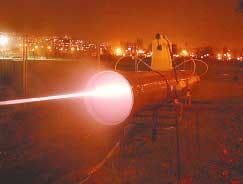Intense ultrafast pulsed laser beams have successfully been sent through a laboratory fog that approximates cloudy atmospheric conditions by Jean-Pierre Wolf and others at the Université Claude Bernard Lyon (Villeurbanne, France).1 Because water tends to absorb and scatter light, water droplets in the atmosphere plague open-air laser applications, including free-space laser communications, remote pollution monitoring, and rangefinding. The pulses produced by the group's laser, however, create nonlinear effects in the artificial cloud, allowing the light to propagate without losing much energy or being diverted (see figure).
The researchers used a chirped-pulse-amplified (CPA) Ti:sapphire laser emitting 810-nm 120-fs pulses at powers of 1014 W/cm2 to create light filaments—streaks of light about 150 µm wide and 10 m long—in the laboratory (higher-power lasers can produce longer filaments). The filaments are caused by a balance between two nonlinear effects that creates quasi-soliton pulses. The Kerr effect modifies the index of refraction of the air and water and focuses the light, while the intense light also ionizes the air molecules, creating a plasma that defocuses the light.
"The striking effect is that the equilibrium is not broken by interaction with one or several droplets," says Véronique Boutou, one of the researchers. The group demonstrated that light filaments survive interaction with water droplets as large as 95 mm and that the filaments can be transmitted through water clouds that have a transmission of 5% (an optical thickness as high as 3.2). "The filament acts as if it doesn't really see droplets," explains Boutou.
An ultrafast laser creates light filaments in the open air that propagate much as solitons propagate in fiber; in both cases, conflicting nonlinear processes create a pulse that neither diverges nor collapses.
The researchers first experimented with a light filament interacting with an isolated water droplet. The filament was generated using 120-fs pulses of about 7 mJ at 810 nm from an ultrafast laser. When the researchers placed water droplets as large as 95 µm in diameter directly in the path of the 150-µm-diameter filament, the filament appeared unaffected, even though one might expect the balance between Kerr self-focusing and plasma self-defocusing to be highly sensitive to environmental changes. When the researchers used absorbing droplets containing black ink, the results were effectively the same.
Photon bath
In fact, the filament does lose energy to the droplets, but it regains the energy from light outside the filament. The filament uses only a fraction of the energy output of the laser; the rest of the energy remains in a photon bath that propagates along with the filament, but has a much larger diameter (about 2 mm). The bath provides an energy reservoir for the filament. As long as the power in the photon bath is sufficiently high, it will feed the filament.
Related experiments by See Leang Chin at Laval University (Quebec City, Quebec, Canada) and others show that if an aperture blocks the photon bath, the filament stops propagating.2 But will the photon bath be able to propagate through droplets, or will it scatter? The French researchers performed a second experiment to measure the energy transmission of the filament through a cloud chamber 35 cm long. They found that elastic scattering does rob energy from the photon bath, and when that energy is reduced beyond a certain value, the filament ends. They found that the filament transmission exponentially decreases with increasing droplet concentration, which indicates that the main source of energy loss is by Mie scattering. The maximum optical thickness measured in the experiments (3.2, corresponding to a droplet concentration of 4 × 105 droplets/cm3) is about the same as that in cumulus or stratocumulus clouds.
"Looking optically through clouds may open unexpected applications and, in this respect, it may be quite a revolution," says Arnold Migus, director of the Laboratoire pour l'Utilisation des Lasers Intenses at the Ecole Polytechnique (Palaiseau, France). "There is still some more work to do to fully model the phenomenon and improve it for applications," he adds.
Next, the group in Lyon plans to test in the open atmosphere using a higher-powered laser. Instead of using a 7-mJ 120-fs-pulse laser, they will use the Teramobile, a mobile amplified CPA-Ti:sapphire laser that provides 400-mJ 80-fs pulses (see Laser Focus World, January 2002, p. 37).3 "Our goal is to control filamentation in the air with the Teramobile system, and once we have filaments at the cloud or fog location, measure its transmission," says Wolf.
REFERENCES
- F. Courvoisier et al., Appl. Physics Lett. 83(2), 213 (July 14, 2003).
- S. L. Chin et al., J. Nonlinear Opt. Phys. Mater. 8, 121 (1999).
- J. Kasparian et al., Science 301, 61 (July 4, 2003).
